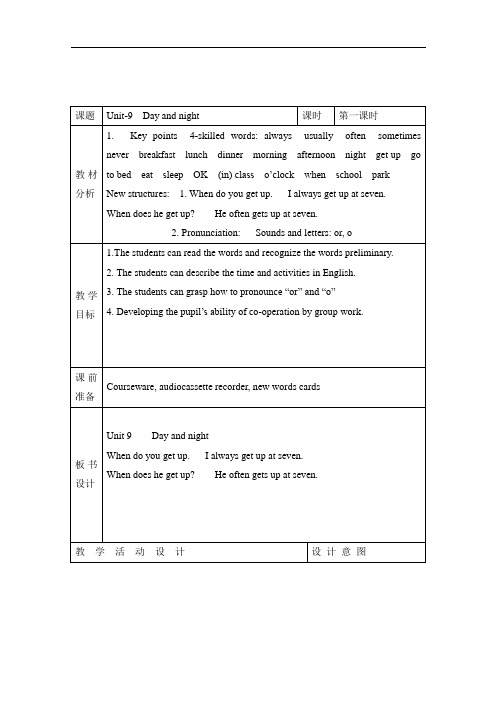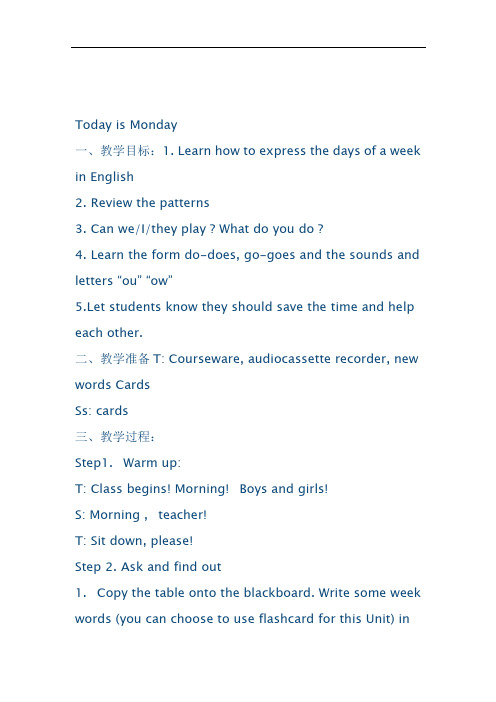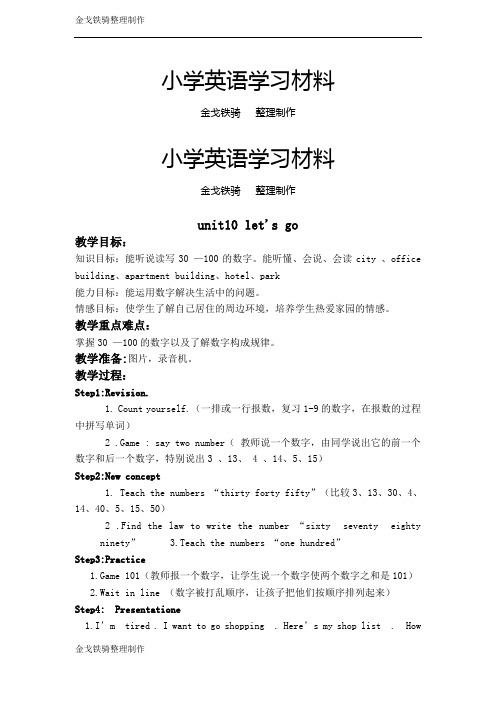北师大版四年级英语下册全册教案
- 格式:pdf
- 大小:137.04 KB
- 文档页数:2

课题Unit-9 Day and night 课时第一课时教材分析1. Key points 4-skilled words: always usually often sometimes never breakfast lunch dinner morning afternoon night get up go to bed eat sleep OK (in) class o’clock when school parkNew structures: 1. When do you get up. I always get up at seven.When does he get up? He often gets up at seven.2. Pronunciation: Sounds and letters: or, o教学目标1.The students can read the words and recognize the words preliminary.2. The students can describe the time and activities in English.3. The students can grasp how to pronounce “or” and “o”4. Developing the pupil’s ability of co-operation by group work.课前准备Courseware, audiocassette recorder, new words cards板书设计Unit 9 Day and nightWhen do you get up. I always get up at seven. When does he get up? He often gets up at seven.教学活动设计设计意图Step1. Warm up:T: Class begins!Morning! Boys and girls!S: Morning ,teacher!T: What day is it today?S: It’s / Today is…T: What do you do on weekend?S: I do my homework.Step 2. Review1. Use the following game to review the structures “What are you doing?”, “I’m (shopping).” (the child pretends to do the action), “ (He) is (swimming).”, and some of the core vocabulary introduced in earlier books (playing, reading, cooking, drinking, eating, sleeping, washing, and painting).2. Divide the class into two teams. Have the child from one teams come to the front of the class. Whisper a word to the child. The chi ld’s team should then ask, “What are you doing?” In response, the child should say, “I’m…” and then pretend to do the action of the word.3. The child’s team scores a point if they can remember the English name for the action. For example, if a child pretends to be sleeping, his or her team should say, “(She) is sleeping.”4. Repeat the procedure with a child from the other team.5. Continue the game until most of the children have had a turn. “The team that scores the most points is the winner. Practise the students’ listeningAnd speakingStep 3. Set the scene1. In Chinese, ask the children what they do immediately after they wake up in the morning on a weekday. Ask, “Do you (get up)?”2. Present the word always. Write the word on the board and explain its meaning. point to the word and model it for the children. Have them repeat it after you.3. Now ask one of the children what he or she does after school. After the child has answered, ask, “Do you always ( play with your friends ) after school?”4. Present the word usually. Repeat the procedure used for always.5. Ask another child what he or she does on Sunday. Then present the words often and sometimes. Repeat the procedure used for always.6. Ask the children, “Do you ever eat breakfast at night?” After the chil dren have answered, present the word never.Step 4. Model the dialog1. Present the flashcard for morning. Explain the meaning of the word. Model the word and have the children repeat it after you.2. Repeat the procedure for the other flashcards ( afternoon, night, breakfast, lunch, and dinner ).3. Present the question, “When do you eat breakfast?” Write the question on the board and explain its meaning to the children. Read the question aloud, pointing to the words as you do so. Have the children repeat the question after you. Ask the children to know the new languages of this unit.Elicit the new words4. Ask the children, “When do you eat breakfast?”Try to elicit, “In the morning.” Present the structure, “I always eat breakfast in the morning.” Repeat the procedure used to model the question.Step 5. Talk about the storyHave the children open their books at pages 26 and 27. Then ask these questions about the pictures:P1: “What is Mocky doing?”(Point to the picture of the watch. Ask, “What time is it?” Elicit, “It’s three o’clock.”)P2: “What is happening now?”P3: “What is Lulu doing?”P4 / 5 / 6: “What is happening now?”P7 : “Can you guess where Ann, Ken, and Mocky are going?”( See if the children can read Uncle Booky’sname. )P 8 / 9: “Where do you think they are now?”P10: “What is Uncle Booky doing?”Step 6. Story1. Say, “Now we’re going to hear what the characters said.” Play the tape without stopping. Have the children look at the pictures as they listen.2. Play the tape again, pointing to each picture. Pausing after each picture. Have the children repeat the words each time.Step 7. Pair work:Ask the students to talk about the time and the activities with their friends . And then act it out. Practise the new sentences. Elicit the new sentencesConsolidate the new sentencesStep 8. Group work:Ask the students to make a new dialogue in their groups. And then act it out.Step 9. Fight game:The students have five minutes to prepare thecompetition.Game 1: Please say out the new words in Chinese.Game 2: Please say out the new words in English.Game 3: Please find out the next sentence.Step 10. Extend:Make a new dialogue.Step 11. Sum up:Today we have learned the present tense. Consolidate the new wordsRaise the students using the sentences ability作业设计Must do: 1. Read the new text 5 times2. Copy the new text 2E 1C3. Recite the new text and words.4. Preview Page 28, 33Choosing do:Do a survey:When do your friends eat breakfast, go to school…?When do your good fiends do his / her homework every day?教学反思The students have grasped the key point sentences, but Someone can’t read it fluently. They must consolidate the text at home.。

Unit11 IllnessLesson 3 Have fun语言知识目标能借助图片指认、说出身体部位名称ear, hair, head, eye, arm, nose, mouth, hand, leg, foot,tummy;能初步运用What` s the matter?My tummy /…hurts.询问或说明哪里疼痛或不舒服;语言技能目标能读懂故事主要内容,利用插图理清故事主要情节。
能用故事中的语言或自己的语言准确回答相关问题;能正确模仿和朗读人物对话及故事。
学习策略目标能够提炼文章的关键信息,在问题的引导下理解语篇的主要内容。
情感态度目标培养良好的卫生意识和习惯,学会关心他人帮助他人。
学情分析四年级下学期的学生已经具备一定的听、说、读、写的能力。
能听懂一些简单的课堂用语,能用简单的英语做事情。
本节课中,教师将指导学生掌握基本的阅读技能,并引导学生用句型“What` s the matter? My head/… hurts. 询问或说明哪里疼痛或不舒服;初步学习身体部位名称。
教学重点:借助插图理解并正确朗读人物对话。
教学难点:说明身体哪里疼痛或不舒服的表达法:My tummy /…hurts.教学过程:一、Warming-upGreeting.Sing a song 《If you are happy》.【设计意图】通过演唱歌曲,使学生注意力快速集中,激发学生的兴趣,歌曲中出现的身体部位单词,为后面的学习做了铺垫。
二、Prensentation1导入故事教师自我介绍爱好是喜欢旅游,借助呈现一张森林的图片,T:I want to go for a field trip.In the forest ,what can I see?(引导学生回答)教师补充,并借助课件图片引出green berries.出示故事中第一幅图,让学生看插图说一说What is Ken doing?接着请学生第一遍看故事。

Today is Monday一、教学目标:1. Learn how to express the days of a week in English2. Review the patterns3. Can we/I/they play ? What do you do ?4. Learn the form do-does, go-goes and the sounds and letters “ou” “ow”5.Let students know they should save the time and help each other.二、教学准备T: Courseware, audiocassette recorder, new words CardsSs: cards三、教学过程:Step1. Warm up:T: Class begins! Morning! Boys and girls!S: Morning , teacher!T: Sit down, please!Step 2. Ask and find out1. Copy the table onto the blackboard. Write some week words (you can choose to use flashcard for this Unit) inthe boxes. Pointing each week word, elicit the correct name from the children.2. Call a child up, and write the A week words in the table under the column. Ask t he child, “Do you like Wednesday?” Elicit the answer from the child. Put a tick under the activities that he / she likes, and write he / she doesn’t like activities.3. Have children open their books at page 11. display your copy of the book, and draw their attention to interview each other student .4. Put children into 4 groups and explain that each child needs to interview at least 3 other children.Step 4. Read with Uncle Booky1. Direct children’s attention to the two rows of words at the bottom of the page. Show your copy of the page and point to the first row of words.2. Play the tape for the first four words. Have the children point to each word that they hear in the tape.3. Ask the children if they can find that all the words have “ ow” or “ ou” sound.4. Tell the children to find out how to read the last two words.5. Play the tape for the last two words and have children repeat.6. Repeat the procedures for the other words.Practice the students’ listening and speaking Ask the children to know the new languages of this unit and at the same time, consolidate the key point for this unit.Ask the children to know the new languages of this unit and at the same time, consolidate the key point for this unit.Consolidate the contents have learned.Ask the children to know the new languages of this unit and at the same time, consolidate the key point for this unit.四、作业设计Must d 1.Read the new words 5 times in part “Sounds and letters” at home.2. Translate the new words into Chinese.3. Preview page 12 .Choosing d Find out some words with “ow” or “ou”.。

小学英语学习材料金戈铁骑整理制作小学英语学习材料金戈铁骑整理制作unit10 let's go教学目标:知识目标:能听说读写30 —100的数字。
能听懂、会说、会读city 、office building、apartment building、hotel、park能力目标:能运用数字解决生活中的问题。
情感目标:使学生了解自己居住的周边环境,培养学生热爱家园的情感。
教学重点难点:掌握30 —100的数字以及了解数字构成规律。
教学准备:图片,录音机。
教学过程:Step1:Revision.1. Count yourself.(一排或一行报数,复习1-9的数字,在报数的过程中拼写单词)2 .Game : say two number(教师说一个数字,由同学说出它的前一个数字和后一个数字,特别说出3 、13、4 、14、5、15)Step2:New concept1. Teach the numbers “thirty forty fifty”(比较3、13、30、4、14、40、5、15、50)2 .Find the law to write the number “sixty seventy eightyninety” 3.Teach the numbers “one hundred”Step3:Practice1.Game 101(教师报一个数字,让学生说一个数字使两个数字之和是101)2.Wait in line (数字被打乱顺序,让孩子把他们按顺序排列起来)Step4: Presentatione1.I’m tired . I want to go shopping . Here’s my shop list . Howmuch are they?Let’s take our number friends to go shopping . Let’s go to the city. (Write it on the blackboard.)What can Jenny see in the city? To teach office building 、 apartment building、 hotel、 park and so on2.Listen and read .Step 5 : Class closing.Sing a song : Where are you going?(应用两只老虎的曲调加入新词)板书设计:课后反思:Common Progress Please Criticize。


北师大版四年级下册全册教案Unit 7 At the Restaurant单元教学目标:技能目标1、能指认、说出食物名称;2、能询问、说明对食物的喜好;3、能理解故事内容;4、能朗读故事。
知识目标1、语音能区别辅音字母k和c在单词中的发音。
2、词汇话题词汇:能指认、说出noodles, fried rice, vegetables, chicken, hamburger, French fries, fruit, bread, dumplings, hot dog等食物名称。
情景词汇:能在语境中理解并排认restaurant, hungry, menu, love等词汇。
3、句型能在语境中运用“What do you like? I like….Do you like…? Yes, I do./No, I don’t.”询问或说明对食物的喜好。
情感、策略、文化意识目标能通过对食物话题的学习,培养健康饮食、合理饮食的意识和习惯,并能通过比较初步了解中西方饮食的差异。
单元内容分析本单元话题是食物,属于《标准(2011年版)》中“饮食”的话题项目。
三年级教材中的“Fruits”和“Vegetables”等单元都属于该话题,而且说明个人喜好的句型“I like beans.”以及noodles 等相关词汇在前面的学习中也已渗透。
教师可以结合这些相关内容,引导学生学习新语言。
在语境中学习和使用“What do you like? I like/I don’t like….Do you like…? Yes, I do./No, I don’t.”询问和回答对食物的喜好是本单元主要语言学习内容。
以上主要句型都是在Mocky和Ken一家人到餐馆就餐,相互询问喜欢什么食物的过程中自然呈现。
Mocky想知道Ken和Ann 喜欢什么食物,于是引出了“What do you like? I like…,”句型。
后来,Ken和Ann意识到Mocky 不认识菜单,在帮助Mocky点菜时,引出“Do you like noodles? Yes, I do./ No, I don’t.”等一般疑问句及回答。
Unit 9 Day and night教学设计1一、教学目标:知识能力:1、复习巩固前两单元的教学内容。
2、学习频率副词usually, sometimes, never, always , often.并初步运用。
3、初步感知课文故事,体会功能句型和频率副词的运用环境。
过程方法:采用视听,师生互动,小组合作,调查访问等方法,引导学生在感知,体验,参与和合作中学习并运用英语。
情感态度:1、培养学生主动参与,大胆实践,敢于开口说英语的良好学习习惯。
2、培养学生的合作精神。
二、教学重点、难点:重点:能听懂、会说、会用功能句型。
When do you get up ?I usually get up at 6:00 .或What do you usually do on Sunday?及回答。
理解并初步掌握新单词。
Always , usually, often, sometimes, never.难点:初步掌握频率副词并能在功能句中运用。
三、教具准备:教学课件一套,调查表一份,单词教学卡片数张。
四、实践活动:小组活动,调查访问。
五、板书设计:Unit 9 Day and nightWhen do you get up?always 6:00usually 6:30I sometimes get up at 9:00never 11:00She often gets up early.六、教学过程:(一)、谈话唱歌,激发兴趣。
1、谈话复习第一单元的内容。
T:What day is it today?S:It’s Friday.T:Saturday is coming. Are you happy? Let’s sing an English song.2、展台出示歌曲,师生跟唱歌曲,复习第二单元的内容。
What time is it?(二)感知句型,学习单词。
1、(出示钟表图片)在句型中引入新单词。
T:What’s this?S: It’s a clock.T: What time is it now?S: It’s 6:00.T: It’s time for get up.I get up at 6:30 in the morning.When do you get up?S: I get up at 6:00.2 、在实物展台上,出示调查表,初步理解频率副词。
北师大版四年级英语下册全册教材分析教案全册教材分析一.本册教材特点:大踏步前进;各单元内容联系紧密、前后呼应;每一单元内容设计精巧,环环相扣。
二.本册教材重点攻关:一般现在时(Unit 7-10);将来时(Unit10-11)三.本册各单元话题及Key Structure:Unit 7 The days of wWhat do you dday?I gl.What daday?It’s MondaUnit 8 TWha?It’s one o’clIt’l.It’gl.Unit 9 Day and nigWhen do you get uI always get up at sevWhen does he get up?Hgets up at sevUnit 10 Makin g suggLet’s play footballall we go to a movie?Do we have enough time?Unit 11 The weaWhat are you going to do?I am going to eat dHe is goinga movWe are going to watch a vidIt’s going to be a fine daIt’s goingto bdaUnit 12 Review四.各单元版块构成:Text/Words to learn/L/Let’ssing!(Plagame)/Talk together/Listen andMatch/Reading/Sounds and Letters/UncleBooky’Blackboard/Touch, Ask and Answer/Writing Exercises/Let’ant!/Ask and find out/ Uncle Booky’/Self-aRefl五.本册较上册新增及版块变化、扩充内容:1.Reading篇幅加大;增加了回答问题的练习。
Lesson 6教学内容:Revision教学目标:复习本单元的句型及单词。
教学重点:正确朗读句型及单词。
教学难点:正确运用句型。
教具准备:教学过程:1.Uncle Booky讲故事(1)让学生翻开第36页,看图。
问学生是否知道这个故事。
让学生用双语讲一讲。
(2)说:“现在我们一起听一听这个故事。
”(3)放录音,让学生合上书听故事。
(4)让学生打开书,看图。
(5)让学生在故事中找熟悉的词语。
(6)让学生默读故事,鼓励他们猜测生词的意思。
(7)这一部分的重点在于让学生整体理解故事内容,因此不对生词作要求。
2.Is it cold?(1)让学生拿出下列卡片:rice, hamburger, lemon, soup, ice cream。
(2)游戏前全班一起复习词汇和句型的结构。
(3)把学生分成两人一组,每组准备这五张卡片。
让学生把卡片正面朝下放。
(4)给学生解释两人轮流拿起一张卡片,让对方猜出是什么。
告诉学生答案只有五种可能,并且注意不要让对方看到卡片的正面。
(5)每次猜的学生必须问:“Is it (hot)?”另一个学生回答:“Yes, it is.”或“No, it isn’t.”(6)猜的学生继续问问题,直到猜出正确的名称:“Is it (cold)? Is it (sweet)?... (ice cream)!”然后两个互换角色。
(7)游戏继续进行直到用完全部卡片。
3.Bingo.4.Snap.5.自我评价。
课后小记:1。